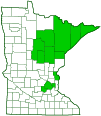thimbleberry
(Rubus parviflorus)
Conservation • Wetland • Description • Habitat • Ecology • Use • Distribution • Taxonomy
Description |
||
Thimbleberry is an erect perennial shrub that rises from an underground horizontal stem (rhizome). It can be 40″ to 80″ long, though in Minnesota it is usually no more than 18″ to 48″ in height. It often forms large, dense clumps. A series of biennial stems (canes) are sent up from the perennial rhizome. The canes are erect to ascending, and unbranched. They do not have bristles or prickles. In the first year they are green and are covered with glandular hairs. In the second year they are woody and hairless and the bark is thin, tan, papery, and flaky. The leaves are large, alternate, deciduous, and long stalked. The leaf stalks are 2¼″ to 7″ long and are covered with reddish, gland-tipped hairs. At the base of each leaf stalk there is a pair of leaf-like appendages (stipules). The stipules are lance-shaped and ¼″ to ¾″ long. The leaf blades are velvety to the touch, round to kidney-shaped in outline and about as long as wide. They are usually 4″ to 8″ long, sometimes up to 12″ long. They and are heart-shaped or deeply cut at the base, and are palmately cut into usually 5, sometimes 3, shallow, pointed lobes. The lobes are cut no more than one third of the way to the midvein. The upper surface is green and sparsely to densely covered with short hairs. The lower surface is somewhat lighter green and similarly hairy but with glandular hairs along the main veins. The margins are irregularly toothed or double toothed with sharp, forward-pointing teeth. The inflorescence is either a single flower or a long-stalked, leafy, flat-topped cluster (corymb) with 2 to 10 large flowers at the end of the stem. They appear from May to late July, peaking in late June to late July. Each flower is in a ⅜″ to 1½″ long stalk (pedicel). The pedicel is densely covered with glandular hairs. The flowers are 1⅜″to 2″ in diameter. There are 5 sepals, 5 petals, and numerous stamens. The sepals are green, egg-shaped to triangular, and have a narrow, elongated, tail-like tip. They are ⅜″ to 11 ⁄16″long including the tip. They are covered on the back (outside) with very short, orangish-yellow, gland-tipped hairs; and on the inside with white non-glandular hairs. The petals are white, broadly egg-shaped to nearly circular, and ⅝″to 1″ long. They have a texture like crinkled tissue paper. The stamens are pale yellow. The fruit is a juicy, fuzzy, broadly hemispheric, ⅝″ to ¾″ wide aggregate of multiple drupelets. It is initially pinkish-white, becoming progressively darker pink, eventually bright red when ripe. It matures in early August to mid-September. When ripe it falls intact to the ground. |
||
Height |
||
40″ to 80″ |
||
Flower Color |
||
White |
||
Similar Species |
||
Habitat |
||
Moist to moderate moisture. Forest clearings, woodland openings, thickets, roadsides, power lines. Partial sun. |
||
Ecology |
||
Flowering |
||
May to late July |
||
Pests and Diseases |
||
thimbleberry stem gall wasp (Diastrophus kincaidii) |
||
Use |
||
|
||
Distribution |
||||
|
Sources |
|||
| 2/14/2023 | ||||
Nativity |
||||
Native The primary range for this species is western North America, stretching from New Mexico to the Pacific coast and north to Alaska. The presence of isolated populations in the Great Lakes region is probably due to a once contiguous range separated by repeated glaciations. |
||||
Occurrence |
||||
Uncommon but often locally abundant |
||||
Taxonomy |
|||
| Kingdom | Plantae (Plants) | ||
| Division | Tracheophyta (Vascular Plants) | ||
| Subdivision | Spermatophytina (Seed Plants) | ||
| Class | Magnoliopsida (Dicots) | ||
Order |
Rosales (Roses, Elms, Figs, and Allies) | ||
Family |
Rosaceae (Rose) | ||
| Subfamily | Rosoideae (Brambles, Roses, Strawberries, and Allies) | ||
| Tribe | Rubeae (bramble) | ||
Genus |
Rubus (brambles) | ||
| Subgenus | Anoplobatus | ||
Subordinate Taxa |
|||
Plants from coastal California have been recognized as var. velutinus. The underside of the leaves tend to be densely hairy. However, this may be an environmentally induced variation. Most taxonomists do not recognize any varieties of thimbleberry. |
|||
Synonyms |
|||
Rubacer tomentosum Rubacer velutinum Rubus nutkanus Rubus nutkanus var. velutinus Rubacer parviflorum Rubus parviflorus ssp. velutinus Rubus parviflorus var. bifarius Rubus parviflorus var. grandiflorus Rubus parviflorus var. heteradenius Rubus parviflorus var. hypomalacus Rubus parviflorus var. parvifolius Rubus parviflorus var. parviflorus Rubus parviflorus var. velutinus |
|||
Common Names |
|||
salmonberry thimbleberry western thimbleberry |
|||
Glossary
Aggregate fruit
A compound fruit consisting of many separate individual fruits derived from separate ovaries in a single flower, like a raspberry or blackberry.
Corymb
A flat-topped or convex inflorescence in which the stalked flowers grow upward from various points on the main stem to approximately the same horizontal plane. The outer flowers open first.
Drupe
A fleshy fruit with a single hard, stone-like core, like a cherry or peach.
Glandular hairs
Hairs spread over aerial vegetation that secrete essential oils. The oils act to protect against herbivores and pathogens or, when on a flower part, attract pollinators. The hairs have a sticky or oily feel.
Palmate
Similar to a hand. Having more than three lobes or leaflets that radiate from a single point at the base of the leaf.
Pedicel
On plants: the stalk of a single flower in a cluster of flowers. On insects: the second segment of the antennae. On Hymenoptera and Araneae: the narrow stalk connecting the thorax to the abdomen: the preferred term is petiole.
Rhizome
A horizontal, usually underground stem. It serves as a reproductive structure, producing roots below and shoots above at the nodes.
Sepal
An outer floral leaf, usually green but sometimes colored, at the base of a flower.
Stipule
A small, leaf-like, scale-like, glandular, or rarely spiny appendage found at the base of a leaf stalk, usually occurring in pairs and usually dropping soon.
Visitor Photos |
|||||
Share your photo of this plant. |
|||||
| This button not working for you? Simply email us at info@MinnesotaSeasons.com. Attach one or more photos and, if you like, a caption. |
|||||
Luciearl |
|||||
Found on the Superior Hiking trail, about 3-4 ft. tall. In one area of the trail it seemed to be everywhere. |
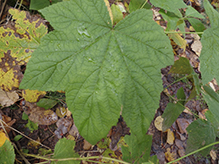 |
||||
Bill Reynolds |
|||||
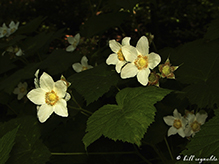 |
|||||
MinnesotaSeasons.com Photos |
|||||
Habitat |
|||||
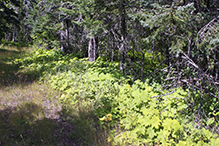 |
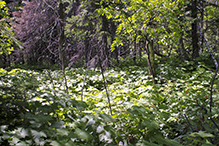 |
||||
Plant |
|||||
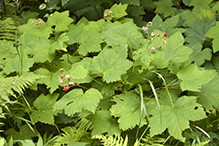 |
|||||
Infructescence |
|||||
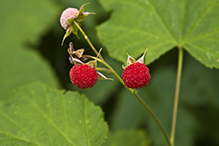 |
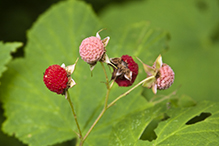 |
||||
Fruit |
|||||
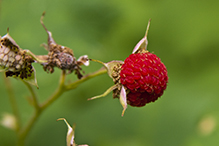 |
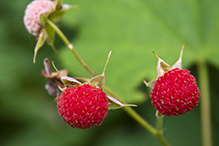 |
||||
Leaves |
|||||
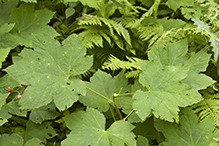 |
|||||

Slideshows |
||

Visitor Videos |
|||
Share your video of this plant. |
|||
| This button not working for you? Simply email us at info@MinnesotaSeasons.com. Attach a video, a YouTube link, or a cloud storage link. |
|||
Other Videos |
|||
| Thimbleberry Flowers (Rubus parviflorus) Wandering Sole TV |
|||
About
Published on Jul 6, 2012 Blossoms on thimbleberry shrubs in the East Kootenays. |
|||
| Rubus parviflorus Eugen Helmbrecht |
|||
About
Uploaded on Oct 14, 2009 Dendrology class |
|||
| Rubus parviflorus wetvideocamera |
|||
About
Published on Oct 26, 2013 Thimbleberry is a shrub that grows up to 3 meters in height. Large white flowers in the spring give way to rounded seedy edible berries. June 2013 |
|||

Visitor Sightings |
|||||
Report a sighting of this plant. |
|||||
| This button not working for you? Simply email us at info@MinnesotaSeasons.com. Be sure to include a location. |
|||||
| Luciearl October 2019 |
Location: Cook County, Superior Hiking Trail Found on the Superior Hiking trail, about 3-4 ft. tall. In one area of the trail it seemed to be everywhere. |
 |
|||
| Bill Reynolds 6/25/2005 |
Location: near the lower falls at Gooseberry Falls State Park. |
 |
|||
MinnesotaSeasons.com Sightings |
|||||

|
Created: Last Updated: © MinnesotaSeasons.com. All rights reserved. |
